
How to Downsize Your Home: My Top 12 Proven Decluttering Tips
Declutter
When I decided to move onto a 41-foot sailboat with just a couple hundred square feet of living space, I knew I had to get rid of boatloads of stuff (no pun intended). I’d been renting a room in an apartment near San Francisco and had furniture, clothes, knick-knacks, and books. If, like me, you’re wondering how to downsize your home, you’ve come to the right place.
At first, downsizing your home may seem like a daunting task. How do you decide what to get rid of and what to keep? How do you drastically downsize? Should you rent a storage unit? The list of questions may feel endless, but taking action will soon quiet down that inner monologue.
I only had one month to downsize and move out, so no time for endless reminiscing or hemming and hawing. In those four weeks, I got rid of most of my stuff and fit the rest in a few gray bins that I stored in my mom’s attic.
It’s been four years since I’ve been mostly stuff-free, and I’ve never felt better. Getting rid of stuff sets us free, removes us from the rat race, and gives us a sense of well-being.
If I could downsize my belongings to fit inside a tiny home like a sailboat, you can, too. Whether you’re staying in your current house or moving into a smaller place, I hope these tips motivate you to start downsizing your home immediately.
You’ll be forever thankful you did.
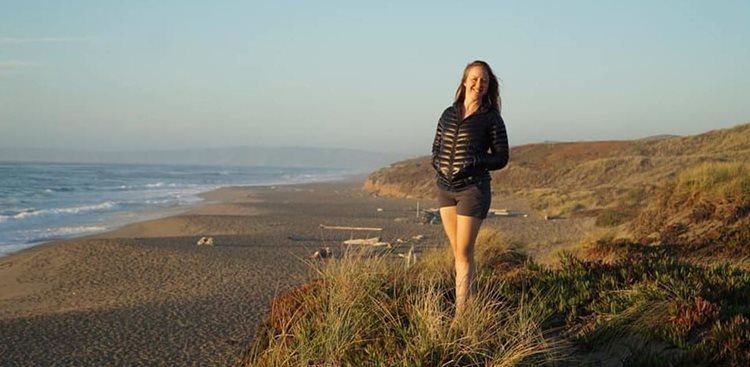
After downsizing, Kristin Hanes has more time to enjoy the outdoors while running her successful business.
1. Know Your "Why" for Downsizing Your Home.
While a 30-day deadline to move onto a sailboat gave me a major kick in the pants to start downsizing right away, your goal may not be as concrete. Just as important as knowing how to downsize your home, though, is knowing why you’re downsizing your home.
Chris DiCroce, the author, sailor, and minimalist behind chrisdicroce.com, says it’s a good idea to articulate your goal/dream/desire for downsizing your home. Put it into one simple sentence you can refer back to often.
“When the process becomes difficult, you can lean back on that goal for support,” he says. “Whether it’s going sailing, becoming debt-free, or living a simpler life, write it down and have it in a visible place. That will be a daily affirmation that will keep you focused on your goal. For me, I posted a picture of the sailboat I wanted on my bathroom mirror. It was the first thing I saw in the morning and the last thing I saw before bed.”
Make sure your goal is motivating and keeps you on track, and make it a point to read that sentence daily.
2. Create a Schedule.
Often, you’re downsizing your home because of an impending move, renovation, or other deadline-driven occurrence. If you’re in a situation like this, you’re likely wondering how to downsize in 30 days or less.
Having to rush through a decluttering process may leave you feeling overwhelmed. My advice, though, is to not let your emotions keep you from making progress. Every hour counts right now!
So how do you drastically downsize? One of our favorite decluttering hacks is to make a schedule/decluttering checklist that starts with your move date and works backward to the present. See how much time you have to work, and divide your decluttering tasks between the available days.
To prioritize, list all your home’s areas (this may or may not be actual rooms — think more about the stuff in your house and where that stuff is located). Then, rank and organize them from easiest to declutter to most difficult. Start with an easy area, then move to those more challenging rooms.
The following tips provide more information on how to define these “easy” and “tough” areas.
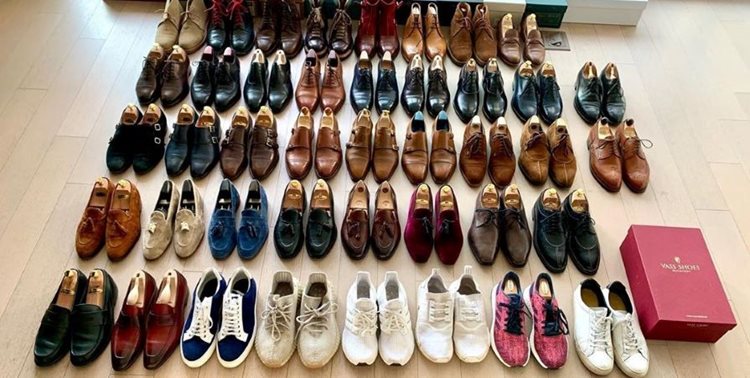
Duplicate items can be some of the easiest to declutter. I mean, how many leather dress shoes do we really need?
(Source: @willlimitless via Instagram)
3. Start With the Easy Stuff.
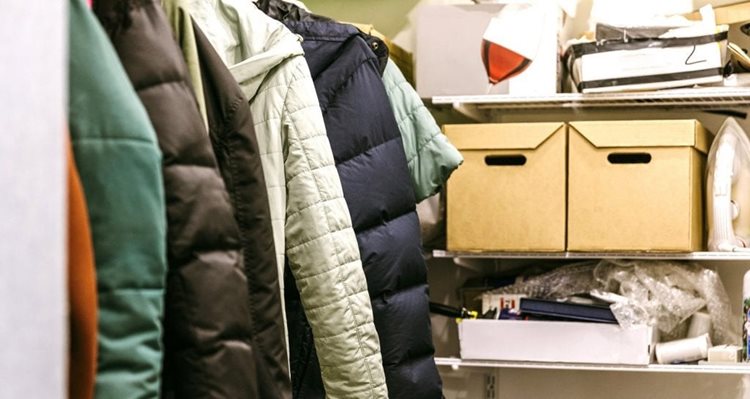
Chances are, if you already have items boxed up, you don’t use or need them.
4. Take Stock of What You Use and Need.
When you downsize room by room, it’s important to consider what you truly use and need. I knew I wouldn’t need my full-size bed and chest of drawers on a sailboat, so I immediately got rid of those things. Since I’d also recently lost my job, I got rid of a lot of my work clothes and high-heeled shoes.
While it was difficult to let go of those things on some level, I also knew they’d be easy to replace should I ever need an apartment or office job again.
As you assess what you really use, consider getting rid of duplicate items. Do you really need five different moisturizers? What about several sets of measuring cups? Do you really use 15 plates on a regular basis?
Keep only what is currently valuable in your life. Remember, it’s only stuff. It can always be replaced later if you think you’ve made a downsizing mistake.
Trust me, after you get rid of stuff, you’ll barely miss it (if at all) down the road.
5. Figure Out the Best Way To Get Rid of Your Stuff
Part of downsizing your home is getting rid of unnecessary items. You can do this in several different ways. Here are some ideas to help you declutter and banish stuff for good:- Host a garage sale and advertise it on Craigslist, Nextdoor, or on neighborhood Facebook groups.
- Sell stuff online using eBay, Poshmark, Craigslist, OfferUp, LetGo, or Facebook Marketplace.
- Donate stuff to Goodwill or The Salvation Army.
- Post stuff to your neighborhood’s Buy Nothing group.
- Use Freecycle, another great resource for donating items.
- List stuff “for free” on Craigslist and see it disappear within hours.
- Ask friends or relatives if they can use any of your stuff.
What you no longer have use for may become another person’s treasure. In fact, I had way too many gorgeous cast-iron pots when I downsized my home. I gave them to family members to “hold onto for me.” They’ve enjoyed those pots now for years, and I know I can get them back if I ever need them again.
Parting with something temporarily is sometimes easier than parting with it for good.
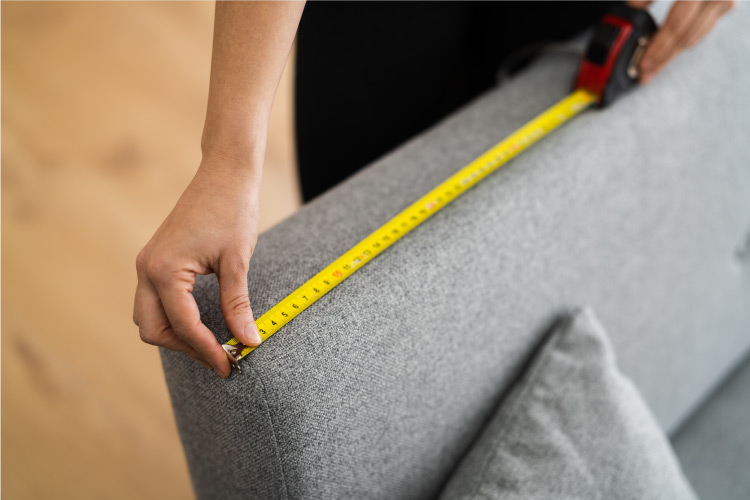
Measure your furniture to see what will fit in your new space.
6. Measure Your Furniture.
If you’re downsizing your home to move into a smaller place, you’ll have to figure out which furniture stays and which goes. The last thing you want is to pay movers and deal with loading and unloading if your stuff isn’t even going to fit.
Take some measuring tape to your couches, end tables, dining room table, and bedroom furniture, and make sure it has a home in your new place.
The more you can get rid of before your move, the better!
Also, make sure you actually use the furniture you’re going to take. Is your bookshelf just home to endless knick-knacks you don’t really care about? Get rid of it! Is your bedroom end table cluttered full of stuff? Think about what can go.
7. Rent a Portable Container for Decluttering.
Since PODS portable containers are delivered right to your driveway, they can help immensely when you’re downsizing and moving. You can put boxes, furniture, and belongings in your container while sorting through things and making decisions.
“Just because something goes in, doesn’t mean it stays in,” said Sherry and John Petersik of the popular Young House Love podcast when they used a PODS container to help their family of four downsize from a whopping 3,150-square-foot home in Richmond, VA, to a cozy 1,400-square-foot beach house in the Florida panhandle.
When you’ve loaded your container to the brim with the stuff you do want to keep, PODS will take it to your new home or wherever you need it — whether it’s across town or across the country.
| Learn all about Sherry and John’s amazing downsizing and home remodeling journey by listening to their Young House Love podcast on Apple Podcasts, Google Podcasts, Stitcher, or your favorite podcast app. |

If your downsizing is temporary (you’re staying in a smaller home while your home is being renovated, traveling for a year, etc.), consider keeping your portable storage container in a secure PODS Storage Center.
8. Consider Longer-Term Storage Options.
The only things I can’t store on my sailboat or in my campervan are my childhood mementos. Really, there’s no room for bins full of childhood artwork, photo albums, yearbooks, and a few treasured toys in a small space.
Luckily, I could store that stuff in my mom’s attic. But most downsizing projects are bigger than mine. Once you’ve assessed what stays and what can go, it’s time to figure out what to do with your stuff when you downsize.
If your downsizing is temporary (you’re staying in a smaller home while your home is being renovated, traveling for a year, etc.), consider keeping your portable storage container in a secure PODS Storage Center. That way, your belongings will be safe and sound until you need them again — no parent attic required.
DiCroce says to be extra critical of what you’re paying to keep, though. “Usually, if we're going to store washers, dryers, or refrigerators, we're paying to store diminishing technology. A year from now, the refrigerators, washers, and dryers will be more efficient than the ones you're planning on storing,” he says. “It might be better to sell the appliances and tech you have (that right there could pay to store other items), and replace them when you know what you need in your new life.”
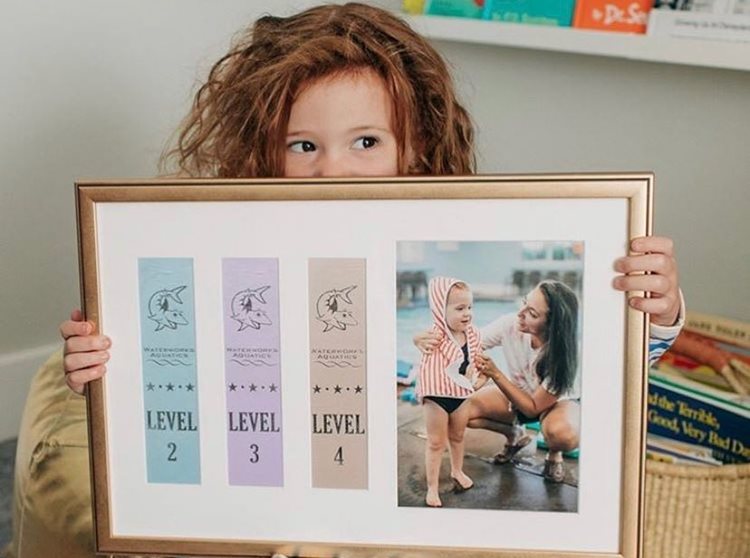
Making art from memories is a fun way to downsize.
(Source: @framebridge via Instagram)
9. Get Creative With Emotional Mementos.
One really hard part about downsizing your home is getting rid of stuff that has emotional value. For me, it was the Breyer horses I played with as a child. I moved those horses from home to home and finally decided to get rid of a bag full of them a couple of years ago.
I almost couldn’t drop them off at the Goodwill, but then I imagined the happy children who would play with my treasured horses. A day after I dropped the horses off, I didn’t think about them again!
I did keep several of the horses to remind me of my happy childhood days. I just didn’t need two boxes full!
If you have birthday cards, letters, or dozens of similar items you’re holding onto, consider keeping just two or three of those items and giving the rest away. For example, my dad had boxes of Christmas and birthday cards that all said basically the same thing. He kept two or three examples and recycled the rest.
Another idea? Consider taking photos of some of your treasured items and turning the photos into art or a wall decoration. Then, you’ll have a reminder of your stuff without actually needing to store it or move it around.
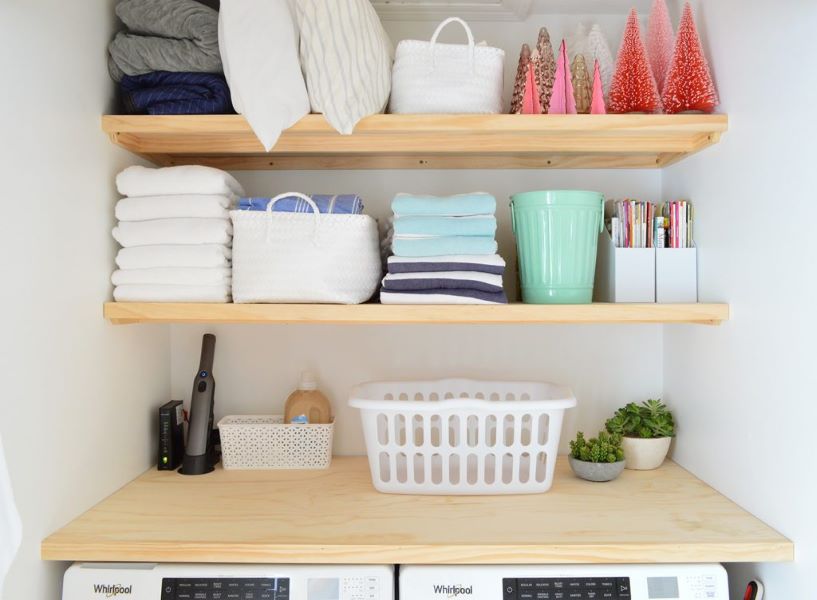
John and Sherry of Young House Love turned their small laundry closet into a workhorse with these quick shelves.
(Source: Young House Love)
10. Think Outside the Box for In-Home Storage.
Once you arrive at your smaller place, or even if you’re staying in your current one, there are ways to get inventive with storage for the things you do keep. Unique storage ideas can keep stuff out of sight and out of mind, reducing clutter and stress.
For example, John and Sherry now have only three closets in their new beach home. “We added shelving and vertical storage to our closets, which got a lot of things off the floor,” said Sherry. “We built several shelves over our washer/dryer, which gave us much more storage space.”
Keeping only what you need and then finding a good home for those items is one way to keep your house open and clutter-free.
11. Don’t Buy More Stuff!
Once you’ve successfully downsized your home, you’ll really enjoy the sense of space, tranquility, and openness you’ve created in your house, your mind, and your life.
Now it’s time to keep that clutter-free existence and put your buying habits in check.
After I got rid of most of my stuff, my buying habits changed. Now, I think critically about each item I buy. I ask myself several questions before making a purchase:
- Do I really need this item?
- Is this item duplicating anything else I currently have?
- What will I get rid of to make room for this new item?
- What purpose does this item have in my life?
- Will I use the item on a regular basis, and does it justify the cost?
I simply don’t have the space to keep multiple versions of the same item, whether that’s running shoes, hiking backpacks, or coffee cups.
12. Hire Professional Help.
Downsizing your home is a big project, and — as the old adage says — many hands make light work. There’s a reason why professional home decluttering services exist. Call in the pros, especially if you’re working with a tight timeline.
Using professional decluttering services and expert organizers will give you a systematic approach to decluttering, helping you make informed decisions about what to keep, donate, or discard. This doesn’t just help eliminate your stuff; it helps eliminate stress, too.
I think you’ll enjoy your newfound freedom. Instead of feeling bogged down by all your stuff, you’ll feel a lightness and energy you can put toward other goals, like hobbies, outdoor activities, and visiting with loved ones.
Hopefully, these “how to downsize your home” tips will leave you feeling inspired and ready to get the ball rolling today!
Kristin Hanes is a writer and blogger who helps people downsize and live in tinier homes, whether that’s a campervan, RV, sailboat, or tiny house on wheels. She now splits her time between the sailboat and a campervan. You can find her blog at The Wayward Home.
Related Articles
Comments
Leave a Comment
Your email address will not be published. Required fields are marked *
